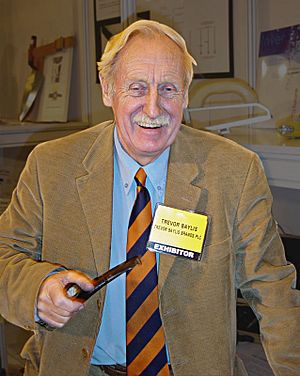Trevor Baylis facts for kids
Quick facts for kids
Trevor Baylis
|
|
|---|---|

Baylis in 2006
|
|
| Born |
Trevor Graham Baylis
13 May 1937 Kilburn, London, England
|
| Died | 5 March 2018 (aged 80) Eel Pie Island, London, England
|
| Known for | Wind-up radio |
| Awards | |
Trevor Graham Baylis (1937–2018) was a clever English inventor. He is most famous for creating the wind-up radio. This special radio does not need batteries or electricity from a wall. Instead, you power it by turning a handle. This action stores energy in a spring, which then makes the radio work.
Baylis invented the wind-up radio to help share important information. He wanted to tell people in Africa about AIDS. He also started a company to help other inventors. His company helped them develop their ideas and protect them.
Contents
Early Life and Adventures
Trevor Baylis was born on May 13, 1937, in Kilburn, London. His mother, Gladys Jane Brown, was an artist. His father, Cecil Archibald Walter Baylis, was an engineer. Trevor grew up in Southall, Middlesex. He went to North Primary School and Dormers Wells Secondary Modern School.
His first job was in a Soil Mechanics Laboratory. There, he studied mechanical and structural engineering.
Trevor was a very good swimmer. When he was 15, he swam for Great Britain. He almost made it to the 1956 Summer Olympics. In 1959, he joined the Royal Sussex Regiment for his National Service. He worked as a physical-training instructor. He also swam for the Army during this time.
After the army, he worked for Purley Pools. This company made the first free-standing swimming pools. Trevor first worked in sales, then moved to research and development. His swimming skills helped him show off the pools. This led him to start his own company. He became a professional swimmer, stunt performer, and entertainer. He performed high dives into a glass tank. He even earned money as an underwater-escape artist in the Berlin Circus. With this money, he started Shotline Steel Swimming Pools. This company supplied swimming pools to schools.
Inventing Great Ideas
Helping Others with Inventions
Trevor Baylis's work as a stunt man showed him the needs of disabled people. Some of his friends had injuries that ended their performing careers. By 1985, he started inventing products for disabled people. He called these products Orange Aids.
The Wind-Up Radio Idea
In the late 1980s or early 1990s, Trevor saw a TV show. It was about the spread of AIDS in Africa. He realized that radios could help share information. This information could help stop the disease. Within 30 minutes, he built the first prototype of his famous wind-up radio.
His first model used simple parts. It had a small transistor radio. It also used an electric motor from a toy car. The clockwork parts came from a music box. Baylis filed his first patent for the invention in 1992.
Bringing the Radio to Life
Even though his prototype worked well, Trevor found it hard to find a company to make it. The big moment came in 1994. His invention was shown on the BBC TV show Tomorrow's World. A film about his radio was made by Liz Tucker. After this, an investor came forward to support his idea.
With money from investors, he started a company called Freeplay Energy. In 1996, the Freeplay radio won two BBC Design Awards. It won for Best Product and Best Design. That same year, Baylis met Queen Elizabeth II and Nelson Mandela. He also traveled to Africa for a documentary about his life. He received the 1996 World Vision Award for Development Initiative.
In 1997, a new Freeplay radio was made in South Africa. This model was smaller and cheaper. It was designed for people in Western countries. It used rechargeable batteries and a crank generator.
Other Inventions and Support for Inventors
In 2001, Baylis walked 100 miles across the Namib Desert. He showed off his "electric shoes" during this walk. He also raised money for the Mines Advisory Group. These special shoes used piezoelectric contacts in the heels. These contacts charged a small battery. This battery could power a radio or a cell phone.
Baylis also created the Trevor Baylis Foundation. Its goal was to "promote the activity of Invention." It aimed to encourage and support inventors and engineers. In 2002, this led to the company 'Trevor Baylis Brands PLC'. This company helped inventors protect their ideas. It also helped them get their products to market. The company wanted to get license agreements for inventors. It also considered starting new companies for good ideas.
Life on Eel Pie Island
For many years, Trevor Baylis lived on Eel Pie Island in the river Thames. He often went to jazz shows at the Eel Pie Island Hotel. He wrote about his life in his 1999 book, Clock This.
In his later years, Trevor faced some health challenges. He passed away on March 5, 2018, at age 80. This happened after a fall on Eel Pie Island. He had also been ill with Crohn's disease. His funeral was held on March 13, 2018. His body was cremated in a special coffin shaped like his famous wind-up radio.
Awards and Recognition
Trevor Baylis received many honors for his work. He was appointed an Officer of the Order of the British Empire (OBE) in 1997. This was for his humanitarian services. He was later made a Commander of the Order of the British Empire (CBE) in 2015. This was for his services to intellectual property.
He also received 11 honorary degrees from universities in the UK. These included Heriot-Watt University in 2003, Leeds Metropolitan University in 2005, and the University of Northampton in 2009.
See also
 In Spanish: Trevor Baylis para niños
In Spanish: Trevor Baylis para niños

